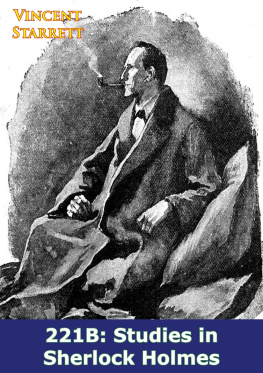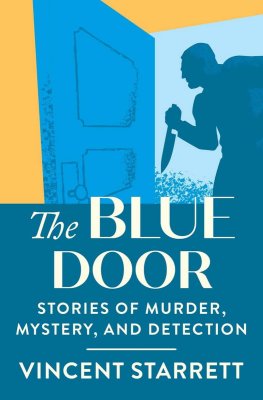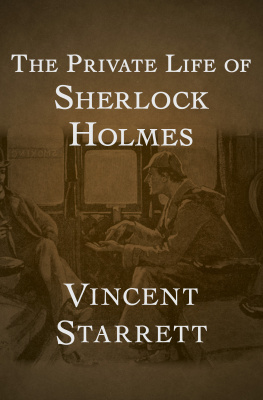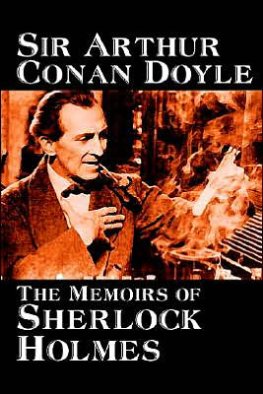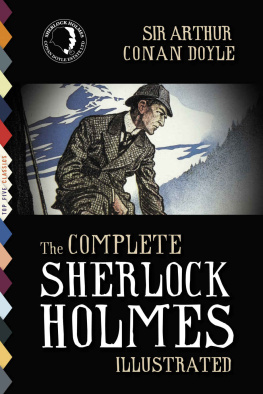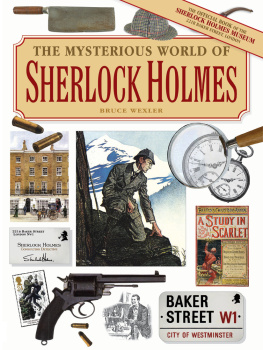

This edition is published by PICKLE PARTNERS PUBLISHINGwww.pp-publishing.com
To join our mailing list for new titles or for issues with our bookspicklepublishing@gmail.com
Or on Facebook
Text originally published in 1940 under the same title.
Pickle Partners Publishing 2016, all rights reserved. No part of this publication may be reproduced, stored in a retrieval system or transmitted by any means, electrical, mechanical or otherwise without the written permission of the copyright holder.
Publishers Note
Although in most cases we have retained the Authors original spelling and grammar to authentically reproduce the work of the Author and the original intent of such material, some additional notes and clarifications have been added for the modern readers benefit.
We have also made every effort to include all maps and illustrations of the original edition the limitations of formatting do not allow of including larger maps, we will upload as many of these maps as possible.
221 B: STUDIES IN SHERLOCK HOLMES
BY VARIOUS HANDS
EDITED BY VINCENT STARRETT

TABLE OF CONTENTS
Contents
ILLUSTRATIONS
Lestrade and Holmes sprang upon him
The birthplace of Sherlock Holmes
Holmes as a plump and dapper blade
A two-minute sketch of Holmes by Steele
Sidney Pagets Holmes and Watson
Watson as Boobus Britannicus
The Baker Street house
The Reichenbach Fall
Bust of Holmes, by Wilkins
A willowy Holmes, by Macauley
William Gillette: sketch by Steele
Arthur Wontner as Sherlock Holmes
First appearance of Baker Street Irregulars
A map of Baker Street
Holmes and Colonel Moran
EXPLANATION
LET US GET back to reality, cried Balzac, impatiently, to a friend who was boring him with tidings of a sick sister. Who is going to marry Eugnie Grandet? And, dying, he murmured: Bianchon would have saved me!referring to the great physician of Paris whom he had himself created.
That is the way one feels about Sherlock Holmes. Let us be done with all this talk ofanything you may happen to dislike in the daily headlines. Let us talk rather of those things that are permanent and secure, of high matters about which there can be no gibbering division of opinion. Let us talk of the realities that do not change, of that higher realism which is the only true romance. Let us talk again of Sherlock Holmes. For the plain fact is, gentlemen, that the imperishable detective is still a more commanding figure in the world than most of the warriors and statesmen in whose present existence we are invited to believe.
In time, no doubt, there will come a day when research students will seek to prove that Adolf Hitler (to take an obvious example) never lived. On that day, I think, a grateful nation will be wearing away the doorstep of a house in Baker Street, Londona house marked by a tablet certifying it to be the indubitable dwelling-place of Sherlock Holmes and Doctor Watson. Already there are indications of this happy development. Did you know that for some years there has been a railway engine wearing the detectives name? It runs in and out of the Baker Street Station, a pleasant reminder of the many railway journeys of Mr. Sherlock Holmes. Already, at the Lyons Prefecture, there is a salon named for the indestructible fathomer; and at Constantinople, during 1920according to the London Times the Turks were certain that the great English detective was at work behind the scenes. It is asserted that, in Switzerland, no year goes by that does not bring to M. Chapuiset, editor of the Journal de Genve, requests for copies of that journal dated May 6, 1891; for it was in that issue, according to Watson in The Final Problem, that an account appearedlater, happily, proved falseof the death of Sherlock Holmes at Reichenbach. Best of all, as more and more the interest of the world centers upon his exploits and every item of association becomes enchanting, the scholars who toil obscurely in the shadow of his reputation dig ever more deeply into available records, seeking new clues and inferences that may help to illustrate this remarkable personality.
Hence, in part, the Baker Street Irregulars; and hence, perhaps, this book. Or, to put it all a little differently, a reprehensible number of us, nowadays, elect to remainas far as possiblein the predicament of Walter de la Mares Jim Jay. This lad, it will be remembered, got stuck fast in yesterday. The difference between Jim Jay and those others of whom I am speaking is that we glory in it. It is comforting in these troubled times to recall the old Strand Magazine of the ninetiesof the turn of the centurywhen, as Earle Walbridge puts it, Sherlock Holmes was adventuring, memoiring, hounding and returning. Recently we have passed through some of the most dramatic months, I suppose, of contemporary history. Stirred by a confusion of emotions, too tangled to untease, we hung above the radio waiting each fresh installment of the fantastic serial, and found it difficult to believe that this indeed was actuality. In one of the intervals of the tragic comedy there were, as I recall, two letters on my desk. In the first, Mr. Arthur Machen, writing from Old Amersham, in Bucks, asked me whether, in my opinion, the house in Baker Street was double or single, and how the lower rooms were occupied. Mrs. Hudson, he agreed, might use one as a best parlour, though he believed this to be unlikely. In the other, Mr. Cornlis Helling, writing from Amsterdam, sent me the first French printing of The Dancing Men, which he thought particularly notable for its half-tone illustration of Sherlock Holmes in his laboratory. With a sigh of relief and pleasure, I knew that I was back in the world of sanity again. There were still men who knew the difference between the false gods and the true, even in that bedeviled phantasmagoria of Europe. Perhaps this personal anecdote will suggest what I mean by the importance of being Jim Jay.
The Baker Street Irregulars (as an organization outside the pages of Dr. Watson) were born in the Bowling Green department of the Saturday Review of Literature, conducted by Mr. Christopher Morley, some time (I should imagine) during the year 1933. Its first formal meeting was held in Chris Celias Restaurant, in New York City, on the evening of June 5, 1934, at which time, a high autumnal wind being out of season, every effort was made to create a favorite alternative atmosphere of thick yellow fog. Simultaneously, the first dinner of the Sherlock Holmes Society of London was going forward in Canutos Restaurant in Baker Street, and suitable greetings were exchanged between the celebrating groups. Some months later, the Honorable Secretary of the English organization, Mr. A. G. Macdonell, visited New York and was a guest of honor (with the late William Gillette) at the second meeting of the Irregulars, also at Celias, on December 7 th , a happy occasion of both wind and fog. Although the original plan of the Irregulars was to foregather annually on the anniversary of Sherlocks birthworked out as falling on January 6no meeting ever has been held upon that date. The dinner of December 7, 1934, indeed, is the last meeting of formal record, at this writing. To quote Mr. Morley, who holds the exalted office of Gasogene, the Baker Street Irregulars are too wise to hold stated meetings, which would belie their name and take the fun out of their indoctrinated amateurishness.
Next page
